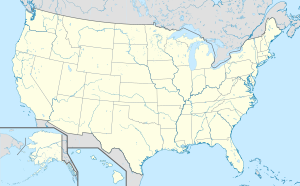Wabash Bridge (Saint Charles)
Coordinates: 38 ° 47 ′ 51 ″ N , 90 ° 28 ′ 2 ″ W.
| Wabash Bridge | ||
|---|---|---|
| The Wabash Bridge in Saint Charles 2007 | ||
| use | Railway bridge | |
| Crossing of | Missouri River | |
| place | Saint Charles and St. Louis County , Missouri | |
| Entertained by | Norfolk Southern Railway | |
| construction | Truss bridge | |
| overall length | 2400 m | |
| Longest span | 191 m | |
| opening | 1871, 1936 | |
| planner |
Charles Shaler Smith (1871) Modjeski & Masters (1936) |
|
| location | ||
|
|
||
The Wabash Bridge , also known as the Saint Charles Rail Bridge , is a single-track railway bridge over the Missouri River between St. Louis County and the city of Saint Charles in the state of Missouri, USA. It goes back to one of the first bridges over the Missouri from 1871, which was built by the North Missouri Railroad . After several parts of the bridge collapsed, the superstructure of the truss bridge was completely renewed by 1884 and the trestle bridges on the access roads were subsequently reinforced. The North Missouri Railroad became part of several railroad companies over the years and was eventually merged into the Wabash Railroad , which replaced the old bridge with a new one about one kilometer downstream until 1936; the current operator is the Norfolk Southern Railway .
First bridges from 1871
The first bridge was built in Saint Charles by the North Missouri Railroad between 1868 and 1871 according to plans by Charles Shaler Smith . It enabled the first permanent rail link to St. Louis . Due to the city's geographic location below the confluence of the Missouri and Mississippi rivers, access from the east was only possible via the Mississippi and from the north and west only via the Missouri; the first connection across the Mississippi in the east was not realized until 1874 with the Eads Bridge .
The high main bridge made of wrought iron consisted of three central, wide-meshed lattice girders (trellis girder truss) and four adjoining Fink girders as well as elongated trestle bridges as access routes. The river pillars had a total height of over 30 meters and protruded up to 20 meters below the normal water level into the river bed. A few months after the opening, on November 8, 1871, the western lattice girder collapsed and tore several railroad cars with it. A similar incident occurred on December 8, 1881, when the eastern lattice girder gave way and several railroad cars also fell into the depths. By 1884 the entire superstructure was renewed, with the lattice girders and Fink girders being replaced by Whipple truss girders with the track below.
The bridge changed hands several times, as the North Missouri Railroad was part of several railroad companies over the years and eventually became part of the Wabash Railroad . In order to keep up with the increasing demands on the load capacity of the railway bridges due to the increase in the dead weight of the locomotives and the transport loads, the trestle bridges on the access roads, which were overhauled in 1884, were encased in concrete in 1910 , so that the bridge could be operated for another 25 years.
New building until 1936

The Wabash Railroad replaced the 65-year-old bridge with a new railway bridge about one kilometer downstream by 1936. The engineering office Modjeski & Masters designed a modern Gerber girder bridge with a length of 500 meters and a span of 191 meters above the shipping channel. A 95 meter long lattice girder is attached to the east bank; the total length of the bridge, including the trestle bridges on the access roads, is 2.4 kilometers.
With the gradual shift of private transport to the road, the Wabash Railroad had to cease passenger transport in the 1960s due to falling numbers of passengers. In 1964 it was taken over by the Norfolk and Western Railway , which in turn became part of the Norfolk Southern Railway in 1990; the bridge uses this today for rail freight traffic . In 1992, the Discovery Bridge for the Missouri Route 370 was put into operation in the immediate vicinity of the railway bridge .
literature
- The St. Charles Bridge. In: Railroad Gazette. Vol. 3, June 3, 1871, pp. 114 and July 8, 1871, pp. 169-170 and Inset sheet .
- Valerie Battle Kienzle: St. Charles. Arcadia Publishing, 2012, ISBN 978-0-7385-9114-8 , pp. 9-13.
- James W. Erwin: St. Charles, Missouri: A Brief History. Arcadia Publishing, 2017, ISBN 978-1-4671-3619-8 , pp. 126-135.
Web links
- St. Charles Rail Bridge. John Marvig Railroad Bridge Photography.
- NM - Missouri River Bridge. , Wabash - First Missouri River Bridge. and NS - Saint Charles Rail Bridge. Bridgehunter.
- Wabash Bridge. John A. Weeks III.
- Wabash Bridge, St. Charles, MO, 1930. Video of the first Wabash Bridge on YouTube .
Individual evidence
- ↑ The St. Charles Bridge. In: Railroad Gazette. Vol. 3, June 3, 1871, p. 114.
- ↑ The St. Charles Bridge. In: Railroad Gazette. Vol. 3, July 8, 1871, pp. 169-170 and Inset sheet .
- ↑ James W. Erwin: St. Charles, Missouri: A Brief History. Arcadia Publishing, 2017, ISBN 978-1-4671-3619-8 , pp. 126-135.
- ^ Converting a Steel Trestle Into a Reinforced-Concrete Trestle. In: Engineering News. Vol. 64, No. 19, 1910, p. 504 f.
- ↑ St. Charles Rail Bridge. John Marvig Railroad Bridge Photography; accessed on May 6, 2018.



